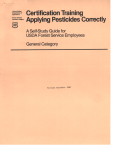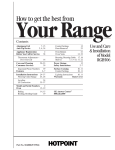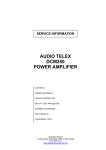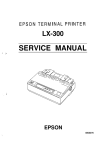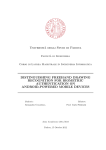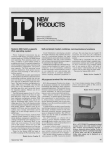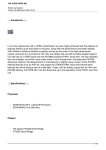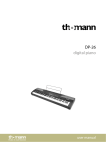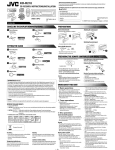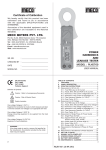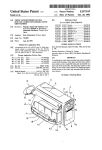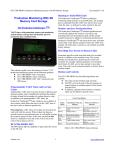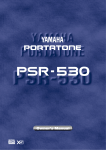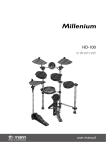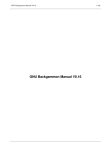Download Performance information making device and method based on
Transcript
USOO6211453B1 (12) United States Patent (10) Patent N0.: US 6,211,453 B1 (45) Date of Patent: Apr. 3, 2001 Kurakake (54) PERFORMANCE INFORMATION MAKING 4,708,046 * 11/1987 Kozuki ................................. .. 84/610 DEVICE AND METHOD BASED ON 5,406,024 ACCOMPANIMENT RANDOM SELECTION PATTERNS OF 5,679,913 , , * 10/1997 gayatshli Bruti 0 e et a. al. et al. .................... 84/609 5,698,804 84/610 _ (75) Inventor‘ . Yasush‘ Kurakaker Hamamatsu (JP) Notice: (30) U.S.C.154b b Primary Examiner—Stanley J. WitkoWski (74) Attorney, Agent, or Firm—Rossi & Associates Od ays . (57) I Foroigri Aooiioooiori Priority Doro (JP) ................................................. .. 8-276461 th t d l d ' f t' f plurality of accompaniment patterns suitable for the music piece. For every predetermined performance section Int. Cl. .............................. .. G10H 1/26; G10H 1/36 US. Cl. ........................... .. 84/609; 84/610; 84/477 R Field Of Search ................... .. 84/609—614, 634—638, 84/477 R _ (56) (Composed of, for example, two measures) of the music piece, a particular accompaniment pattern is randomly selected from among the prestored accompaniment patterns suitable for the music piece. Accompaniment performance information for the music piece is provided by combining References Clted the accompaniment patterns randomly selected for the indi U'S' PATENT DOCUMENTS 4,539,882 * ABSTRACT gtivinmriiciiygiecirin?eogif$135515;16361333552if 3 7 (51) (52) (58) ..... .. 07104744 4/1995 (JP) ' * cited by examiner Oct. 9, 1997 Oct. 18, 1996 MiZuno 1/1998 Sakama et a1. ...................... .. 84/610 FOREIGN PATENT DOCUMENTS (21) AppL NO‘: 08/948,307 _ 12/1997 Subject to any disclaimer, the term of this patent is extended or adjusted under 35 ( ) y (22) Filed: * 5,712,436 * (73) Assignee: Yamaha Corporation (JP) (*) 4/ 1995 Shioda _~ vidual performance sections. 9/1985 YuZaWa ................................ .. 84/610 12 Claims, 10 Drawing Sheets SU‘JG DATA SONG CHORD PART 1 MELwY SONG 2 CI-DRD PRCXERESSIU‘J SONG 43 CLIP PART 21 FOR 16 MMSURES FOR 2 MEASURES ANIMATION CLIP PART 3 ICDN SONG 1O CLIP PART 4 CLIP PART 5 ta ta ETC. U.S. Patent Apr. 3, 2001 MEASURE Sheet 3 0f 10 US 6,211,453 B1 CLIP SFQUEACE DATA SEQUEMIE l N CLIP PART NO. SEQUEACE 2 SEQUEI‘KE 3 SEQUEI‘CE 4 SEQUENCE 5 SEQUENE 6 SEQUEMIE 7 SEQUENCE 8 FIG. 3 SONG SEIETIN? SWITCH PROCESS S11 YES S12 ’\/ LORD SG‘JG DATA, (DRRE. TO ACl'UA'lED SWITCH, FRGA HARD DISK TO RAM I S13 ’\’ INITIALIZE A% (IILIP SEQUENCES I S14 ’\-* DISPLAY IOON, CORRE. TO CLIP PART 1, ON All, FRAMES OF SUB-MGVITOR SQIEEN FIG- 5 U.S. Patent _ ,._ Apr. 3, 2001 Sheet 4 0f 10 US 6,211,453 B1 »SW! l\ a 53 \. w \' ,- /F% a g 5 ?/Qa ‘E ‘mg L; Emmi a "59mm ‘5 gmn EWL ‘-' l1 g E FIG.4 U.S. Patent Apr. 3, 2001 Sheet 5 0f 10 US 6,211,453 B1 CLIP SELECTIMB LEVER PROQSS S21 NO PLAY=O ‘? YES DISPLAY sEQuENrIAmmANmm IOONS 0F INZ'IVIDUAL CLIP PAR'IS ON w 522 LEFT [RIGHT] 4 FRAMES 0F SUB-MONITOR S23 HAS PREDETERMINED TIME PERIOD EIAPSED ‘? GENERATE 4 RANDOM NUMBERS R1-R4 ~ 524 (VALUES RANGIM} FROM 1 T0 5) L WRITE INDIVIDUAL VALUES INTO FORMER-HALF [IAT'I‘ER-HALF] 4 CLIP ’\’ S25 SEQUENCE AREAS CORRE. T0 RANDGJ NUMBERS R1-R4 DISPLAY ICONS 0F CLIP PARTS CORRE. TO INDIVIDUAL NLMERICAL VALUES ON ’\/ S26 LEFT [RIGHT] 4 FRAMES 0F SUB-MONITOR SCREEN (DRRE. T0 RANDOM NUMBERS R1~R4 FIG- 6 U.S. Patent Apr. 3, 2001 Sheet 6 0f 10 US 6,211,453 B1 PLAY SWITCH PRO(ESS P LAY‘-—1 N S32 SELHIT 1ST CLIP N S33 SEQUENE AREA I PERMIT INTERRUPF PROCESS & ’\/ S34 FIG- STOP SWITGI PROESS I DEADEN CIHIRENTLY-GENERATED ’\/ S43 TO‘JE, IF ANY I INHIBIT INI'ERRUPT PROGESS ’\/ S44 @FI '7 U.S. Patent Apr. 3, 2001 Sheet 7 0f 10 US 6,211,453 B1 INTERRUPT PROCESS REPRODUCE MELODY ’\’ S51 I READ OUT CIDRD FROM ’\/ S52 CHORD PROGRRESIO‘J I REPRODUGE MIXM- ’\/ S53 PANIME‘JT PATTERN I I REPRODUOE ANIMATION "\/ S54 INCREMENI‘ C(IJNI'ER ’\-' S55 S56 NO (IIJNTED TWO MEASURES ‘? YES ADVANCE CLIP SEQUEME N S57 I CLEAR C(IJNTER ’\/ S58 FIG- 9 U.S. Patent Apr. 3, 2001 Sheet 8 0f 10 US 6,211,453 B1 SAVIAG SWITCH PROCESS S6 1 NO YES SAVE MELODY PART ’\-/ S62 I SEIECT Am. PATTERNS IN ORDER CORRE. TO CLIP SEQUENCES, M(DIFY NOTES ON THE BASIS OF CHORD ’\/ S63 PROGRESSIGg? SAVE MIXM. FIG. 10 U.S. Patent Apr. 3, 2001 Sheet 9 0f 10 US 6,211,453 B1 hH HU 625g% S0ON2TQ 85c :26 @NJ w Q.NmvM?KwNmC1zZQaT m523a.67g%8?maEé25m8z6%w0 NM" Hm w w 653m 295m 8EmD.235aT0w?om. mam \.nE.omMNHNmNOmlN m2:NEmg U.S. Patent Apr. 3, 2001 US 6,211,453 B1 Sheet 10 0f 10 MELODY CIDRD PROGRESSION CLIP PART 1 CLIP PART 2 CLIP PART 3 * NORMAL CLIP PART 4 CLIP PART 5 CLIP PART 6 > INTRO CLIP PART 7 CLIP PART 8 * ENDIAG CLIP PART 9 CLIP PART 10 r FILL-IN CLIP PART 11 J FIG. 12 US 6,211,453 B1 1 2 PERFORMANCE INFORMATION MAKING DEVICE AND METHOD BASED ON RANDOM SELECTION OF ACCOMPANIMENT PATTERNS provided a reproducing device that reproductively performs BACKGROUND OF THE INVENTION The present invention relates to a performance informa tion making device and method Which are capable of easily creating various variations of accompaniment patterns Well suitable for a music piece melody and thereby alloW even unexperienced users or beginners to fully enjoy composing 10 a music piece. There has been knoWn a technique Which, in making music piece data (performance information) by combining 15 automatic performance patterns on an automatic perfor mance device or the like, greatly facilitates editing and modi?cation of the music piece data. Such a technique is a melody and accompaniment of the given music piece on the basis of the melody information prestored in the storage device and accompaniment performance information com prising a combination of the accompaniment patterns selected by the pattern selecting device. According to another aspect of the present invention, there is provided a performance information making method Which comprises the steps of: prestoring information repre sentative of a plurality of accompaniment patterns suitable for a given music piece; and for each of predetermined performance sections of the given music piece, randomly selecting a particular accompaniment pattern from among the plurality of accompaniment patterns suitable for the given music piece, so that accompaniment performance information for the music piece is provided by combining the accompaniment patterns randomly selected for indi vidual ones of the performance sections. disclosed in, for example, Japanese patent Laid-open Pub The performance information making method may further comprise the steps of: prestoring melody information of the given music piece; and reproductively performing a melody lication No. HEI-7-104744 that corresponds to US. patent application Ser. No. 08/312,776. The technique disclosed in the HEI-7-104744 publication is characteriZed primarily by visually displaying a plurality of display elements (e.g., icons) corresponding to a plurality of performance patterns and accompaniment of the given music piece on the basis of the prestored melody information and accompaniment per as Well as lines specifying order of the performance patterns 25 formance information comprising a combination of the accompaniment patterns selected for the individual perfor to be played. The disclosed technique alloWs a user to designate a desired combination of the visually displayed mance sections. performance patterns and thereby facilitates user’s editing of music piece data. The performance information making technique disclosed According to still another aspect of the present invention, there is provided a machine-readable recording medium containing a control program executable by a computer. The control program comprises: a program code mechanism that, for each of predetermined performance sections of a given in the HEI-7-104744 publication has the advantage that it provides for easier editing operations to, for example, change the order of the performance patterns. HoWever, the editing requires considerable musical knoWledges, Which Would limit the application of the disclosed technique to relatively experienced users. Therefore, With the disclosed technique, it was difficult for inexperienced users to enjoy composing a music piece. Further, US. Pat. No. 5,406,024 discloses a technique music piece, randomly selects a particular accompaniment 35 given music piece by combining the accompaniment pat terns selected for individual ones of the performance sec tions. According to yet another aspect of the present invention, in correspondence With time-varying phases of a perfor there is provided a machine-readable recording medium containing, in a data storage area thereof, data representative of a melody of a given music piece and a plurality of mance. SUMMARY OF THE INVENTION 45 accompaniment patterns suitable for the given music piece and also containing, in a program storage area thereof, a control program executable by a computer. The control program comprises: a program code mechanism that, for each of predetermined performance sections of the given music piece, randomly selects a particular accompaniment beginners to fully enjoy composing a music piece. In order to accomplish the above-mentioned object, the present invention provides a performance information mak ing device Which comprises: a storage device having pre stored therein information representative of a plurality of accompaniment patterns suitable for a given music piece; and a pattern selecting device that, for each of predetermined and a program code mechanism that generates a series of pieces of accompaniment performance information for the Which uses a bar code scanner to select performance patterns It is therefore an object of the present invention to provide a performance information making device and method Which are capable of generating various variations of accompaniment patterns Well suitable for a a music piece melody and thereby alloW even unexperienced users or pattern from among a plurality of accompaniment patterns provided in advance and suitable for the given music piece; pattern from among a plurality of accompaniment patterns provided in advance and suitable for the given music piece; a program code mechanism that reads out, from the data 55 storage area, the data representative of the accompaniment pattern randomly selected for each of the performance sections; and a program code mechanism that reads out the data representative of the melody from the data storage area; performance sections of the given music piece, randomly and a program code mechanism that reproductively per selects a particular accompaniment pattern from among the forms the melody and accompaniment of the given music plurality of accompaniment patterns suitable for the given music piece, so that accompaniment performance informa tion for the given music piece is provided by combining the accompaniment patterns randomly selected for individual piece on the basis of the read-out data representative of the melody and accompaniment pattern. According to the essential feature of the present invention, accompaniment patterns corresponding to a plu ones of the performance sections. In the performance information making device, the stor age device may also has prestored therein melody informa tion of the given music piece, and there may be further rality of melody performance sections (each having tWo 65 measures) of a music piece are randomly selected from among a plurality of predetermined accompaniment patterns suitable for the music piece, and the randomly selected US 6,211,453 B1 3 4 accompaniment patterns are arranged in predetermined order (e.g., the order of the performance sections) to provide performance information, Which is reproduced along With the melody. Because the randomly-selected accompaniment patterns 11. Speci?cally, the CPU 1 alloWs various data, correspond ing to user’s operation of the keyboard 5 and the mouse 6, to be entered via the input/output interface 4. Thus, the CPU 1 controls the position of a mouse pointer (cursor) on the display device 8 and detects user’s clicking operation on the mouse 6. The CPU 1 can also control the visual presentation on the display device 8 via the video card 7. The sound board correspond to the patterns prestored as suitable for the melody, the reproduced accompaniment information can become suitable for the melody even Where the speci?c nature of the melody and accompaniment patterns are not taken into consideration. Besides, such a random selection 9 constitutes a tone source or tone generator device, Which generates tone signals corresponding to data (e.g., perfor 10 easily provides various variations of accompaniment pat terns. The accompaniment patterns may be reproduced after being converted in tone pitch on the basis of a chord hard disk (HD), ?oppy disk (FD), CD (Compact Disk) progression accompanying the melody. Such a tone pitch conversion permits shared use of a general-purpose accom 15 paniment pattern of a predetermined key such as C major. external computer. In the ROM 2, there are prestored basic programs, such as a BIOS (Basic Input Output System), Which are used for controlling basic input/output operations For better understanding of the above and other features of the present invention, the preferred embodiments of the of the CPU 1. According to the current embodiment, melody data, chord progression data and data representative of a plurality of accompaniment patterns are prestored as song data for a 25 present invention; FIG. 2 is a diagram shoWing an exemplary storage format of song data in the ?rst embodiment; FIG. 3 is a diagram shoWing an exemplary storage format of clip sequence data in the ?rst embodiment; along With performance-information-making controlling FIG. 4 is a diagram illustrating a picture displayed during performance-information making controlling programs from the hard disk into the RAM 3, so as to control FIG. 5 is a ?oWchart of a song selecting sWitch process performance information making operations on the basis of 35 FIG. 7 is a ?oWchart of a play sWitch process carried out by the CPU in the ?rst embodiment; FIG. 8 is a ?oWchart of a stop sWitch process carried out by the CPU in the ?rst embodiment; the clip part data comprises a set of accompaniment pattern the CPU in the ?rst embodiment; out by the CPU in the ?rst embodiment; data for tWo measures, animation data for tWo measures and 45 FIG. 11 is a block diagram of a performance information making device according to a second embodiment of the present invention; and storage format in a song data memory. DETAILED DESCRIPTION OF THE PREFERRED EMBODIMENTS information, and is converted in tone pitch in accordance With chords speci?ed by the chord progression data When it 55 making device according to a ?rst preferred embodiment of the present invention, Which generally comprises a personal computer and softWare executable by the personal computer. RAM 3 under the control of an OS (Operating System) installed in a hard disk (HD) of the external storage device is to be actually reproduced. The animation and icon data are used for visual presentation on the display device 8 during making of performance information, as Will be later described. When one of the song data is selected during making of The personal computer A includes a CPU 1, a ROM 2, a RAM 3, an input/output interface 4, a keyboard 5, a mouse 6, a video card 7, a display device 8, a sound board 9, a communication interface 10, an external storage device 11 and an address and data bus 12. The CPU 1 performs overall control of the performance information making device, using Working areas of the icon data. Namely, in the hard disk, there are prestored: ten different melodies; chord progressions suitable for the respective melodies, one chord progression per melody; and accompaniment patterns suitable for the respective melodies, ?ve different accompaniment patterns per melody. Further, each of the accompaniment patterns comprises tone pitch information (note codes) in a predetermined musical key (such as C major) and tone generation timing FIG. 12 is a diagram shoWing another example of the data FIG. 1 is a block diagram of a performance information the programs thus stored in the RAM 3 as Will be later described in detail. FIG. 2 is a diagram shoWing an exemplary storage format of the song data prestored in the hard disk in the current embodiment. As shoWn, each of the song data, “song 1” to “song 10”, comprises a set of melody data for 16 measures, chord progression data for 16 measures and ?ve different (kinds of) clip part data, “clip part 1”—“clip part 5”. Each of FIG. 9 is a ?oWchart of an interrupt process carried out by FIG. 10 is a ?oWchart of a saving sWitch process carried total of ten music pieces, and the song data comprise “song 1”—“song 10” corresponding to the ten music pieces. Here, let it be assumed that these song data have been supplied, programs, from the ?oppy disk (FD), CD-ROM or magneto optical disk (MO) of the external storage device 11 and then prestored in the hard disk The CPU 1 stores the making of performance information; carried out by a CPU in the ?rst embodiment; FIG. 6 is a ?oWchart of a clip selecting lever process carried out by the CPU in the ?rst embodiment; ROM, magneto-optical disk (MO) or the like provided in the external storage device 11, and the CPU 1 also communi cates various data With an external MIDI instrument or BRIEF DESCRIPTION OF THE DRAWINGS invention Will be described in greater detail beloW With reference to the accompanying draWings, in Which: FIG. 1 is a block diagram of a performance information making device according to a ?rst embodiment of the mance information) entered under the control of the CPU 1. The generated tone signals are audibly reproduced or sounded through a sound system B as Well knoWn in the art. Further, the CPU 1 communicates various data With the performance information, clip part data for 16 measures corresponding to the length of the melody (i.e., eight clip 65 part data) are selected at random for the selected song data. More speci?cally, as illustrated in FIG. 3, every tWo mea sures from the start of the song (comprising 16 measures) to be reproduced is designated as a performance sequence (“sequence ”—“sequence 8”), and, for each of these sequences, one of the ?ve clip parts, “clip part 1”—“clip part US 6,211,453 B1 6 5 Song selecting sWitch process of FIG. 5 is triggered by 5”, is selected at random to allocate the clip part data to the sequence. Then, for each of the sequences, the selected clip data number (one of numbers 1—5) is stored as clip sequence data in association With that sequence. user’s operation of any one of the song selecting sWitches SW1. At ?rst step S11, a determination is made as to Whether the reproduction ?ag PLAY is at the value of “0” or not. If the reproduction ?ag PLAY is not at “0”, this means that FIG. 4 is a diagram illustrating a picture displayed during reproduction of a song is under Way, so that the CPU 1 returns to a preceding routine Without executing any other making of performance information, on Which are shoWn a main screen section MS for presenting an animation corre sponding to a reproduced song and a sub-monitor screen operations. Namely, user’s selection of a song is made valid only When no other song is being reproduced; that is, any section SS for presenting icons corresponding to a selected clip part. 10 On another section, there are also displayed various sWitches that can be operated through the mouse pointer P movable in response to user’s operation of the mouse 6 and user’s clicking operation on the mouse 6. More speci?cally, neW song can not be selected even When the user actuates any one of the song selecting sWitches SW1 during repro duction of another song. If, on the other hand, the repro duction ?ag PLAY is at “0”, this means that reproduction of a song is not under Way, so that the CPU 1 proceeds to next SW1 for selecting a desired song from among the ten step S12 to load the song data, corresponding to the operated sWitch, from the hard disk of the external storage device 11 to the RAM 3. After step S12, the CPU 1 goes to step S13, different song data; left and right clip selecting levers SLL, Where the clip sequences are all set to an initial value of 1 the displayed sWitches includes: song selecting sWitches 15 (i.e., clip part number “1”). After that, the CPU 1 proceeds SLR for instructing a start of clip part selection to step S14 in order to display, on the sub-monitor screen SS, (accompaniment pattern selection); a play sWitch SW2 for the icons corresponding to clip part 1 in the selected song data and then returns to the preceding routine. instructing a start of reproduction of a song; a stop sWitch SW3 for instructing a stop of reproduction of the song; a FIG. 6 is a ?oWchart of a clip selecting lever process that saving sWitch SW4 for saving data of a song made; a part setting sWitch SW5 for setting a tone volume for each track (performance part) of the song; a main setting sWitch SW6 for setting a main tone volume of the song; and a tempo is triggered by user’s operation of the left or right clip selecting lever SLL or SLR. In the ?oWchart, both the 25 processes triggered by the left and right clip selecting lever SLL and SLR are shoWn together, for simplicity of illustration, because they are different from each other only sWitch SW7 for setting a reproduction tempo of the song. Typically, user’s operation on the screen takes place in the folloWing manner. First, When any one of the song selecting in that the process triggered by the left clip selecting lever SLL is performed on the left four frames (i.e., former half of sWitches SW1 corresponding to a desired song number is a song) While the process triggered by the right clip selecting operated to select a song, predetermined icons correspond ing to the selected song are displayed on eight frames of the sub-monitor screen SS. Then, When the left clip selecting lever SLL is actuated, the icons in the left four frames lever SLR is performed on the right four frames (i.e., latter half of the song). Speci?cally, in the ?oWchart, actions taken in response to operation of the left clip selecting lever SLR are depicted mainly, With actions responsive to operation of sequentially change at random until they stop changing to be ?xedly displayed upon lapse of a predetermined time period. This Way, eight measures (i.e., four accompaniment 35 the right clip selecting lever SLR depicted in brackets. First, at step S21, a determination is made as to Whether the reproduction ?ag PLAY is at “0” or not. If the repro duction ?ag PLAY is not at “0”, this means that reproduction patterns) in the former half of the song are determined randomly. Similarly, by the user actuating the right clip of a song is under Way, so that the CPU 1 returns to a selecting lever SLR, the icons in the right four frames sequentially change at random until they stop changing to be ?xedly displayed upon lapse of a predetermined time period, so that eight measures (i.e., four accompaniment patterns) in preceding routine Without executing any other operations. If, the latter half of the song are determined randomly. Then, once the play sWitch SW2 is actuated by the user, on the other hand, the reproduction ?ag PLAY is at “0”, this means that reproduction of a song is not under Way, so that the CPU 1 proceeds to next step S22. Namely, selection of Which time an animation corresponding to the selected song and accompaniment patterns is displayed on the main screen clipper parts by actuation of the clip selecting lever SLL or SLR is made valid only When no song is being reproduced. At step S22, icons corresponding to the clip parts are displayed on the left [or right] four frames of the sub monitor screen SS While being sequentially changed. At next step S23, it is determined Whether a predetermined time MS. To stop the reproduction, the stop sWitch SW3 is period (i.e., 1—2 seconds) has elapsed or not. If the prede actuated. termined time period has not yet elapsed, the CPU 1 reverts to step S22, While if the predetermined time period has elapsed, the CPU 1 proceeds to next step S24. Four random numbers R1—R4 (numerical values ranging from 1 to 5) are generated at step S24, and at step S25 these values are Written, as clip part numbers, into the former-half [latter-half] four clip sequence areas corresponding to the random numbers R1—R4. At next step S26, clipper part icons the melody of the selected song is reproduced along With the 45 selectively determined accompaniment patterns, during To change either the former-half accompaniment patterns or the latter-half accompaniment patterns, it is only neces sary for the user to operate one of the left and right clip selecting levers SLL, SLR. Such operation of the clip 55 selecting lever provides desired accompaniment patterns, Which can be saved, for example, in the ?oppy disk of the external storage device 11 by actuating the saving sWitch SW4. FIGS. 5 to 10 are ?oWcharts of performance-information corresponding to the numerical values are displayed on the left [right] four frames of the sub-monitor screen SS Which correspond to the random numbers R1—R4, and then the CPU 1 returns to the preceding routine. Thus, in response to the user’s operation of the left or right making controlling programs carried out by the CPU 1 of FIG. 1, and a description Will be made hereinafter about detailed control operations of the CPU 1 on the basis of these ?oWcharts. Reproduction ?ag PLAY is allocated in the RAM 3 and this reproduction ?ag PLAY is set to “1” When reproduction of a song is under Way and set to “0” When reproduction of a song is not under Way. clip selecting lever SLL or SLR, clipper parts in the former 65 or latter half of the song are randomly selected from among the ?ve different clipper parts. Accordingly, accompaniment data are selected randomly and stored as clip sequence data. US 6,211,453 B1 7 8 Play switch process of FIG. 7 is triggered by user’s operation of the play sWitch SW2. At ?rst step S31, a accompaniment data are modi?ed (pitch-converted) on the basis of the current chord to thereby actually reproduce an accompaniment pattern. At next step S54, animation data are determination is made as to Whether the reproduction ?ag PLAY is at “0” or not. If the reproduction ?ag PLAY is not at “0”, this means that reproduction of a song is under Way, so that the CPU 1 returns to a preceding routine Without read out from the same clip part so as to reproduce an animation. After that, the above-mentioned counter is incremented by one at step S55, and a determination is made at next step executing any other operations. If, on the other hand, the reproduction ?ag PLAY is at “0”, this means that the play sWitch SW2 has been actuated When reproduction of a song is not under Way, so that the CPU 1 sets the reproduction ?ag PLAY to “1” at step S32 and then proceeds to next step S33. S56 as to Whether or not tWo measures have already been 10 counted by the counter. If tWo measures have not been counted as determined at step S56, the CPU 1 returns to a preceding routine; hoWever, if tWo measures have been At step S33, the ?rst clip part area of the clip sequence data counted, the CPU 1 updates the register to advance the clip is selected as an initial state for reproduction of a song. A sequence at step S57. Then, the CPU 1 returns to the next step S34, the CPU 1 gives permission to carry out an interrupt process for song reproduction and then returns to preceding routine after having cleared the counter at step S58. Once the clip sequence has advanced to “sequence 8” 15 the preceding routine. Thus, in response to the user’s operation of the play as a result of the operation of step S57, the CPU 1 sets the sWitch SW2 When no song is being reproduced, the CPU 1 clip sequence back to “sequence 1”. Thus, the 16-measure song Will be repetitively reproduced until the stop sWitch behaves to reject user’s subsequent operation of any other SW3 is actuated. sWitch than the stop sWitch SW3 and permit a song repro duction process (interrupt process) as Will be later described. corresponding to randomly selected clipper parts in In the above-mentioned manner, accompaniment patterns, Stop sWitch process of FIG. 8 is triggered by user’s operation of the stop sWitch SW3. At ?rst step S41, a determination is made as to Whether the reproduction ?ag PLAY is at “1” or not. If the reproduction ?ag PLAY is not at “1”, this means that the stop sWitch SW3 has been actuated When reproduction of a song is not under Way, so that the CPU “1” returns to a preceding routine Without executing any other operations. If, on the other hand, the reproduction ?ag PLAY is at “1”, this means that the stop sWitch SW3 has been actuated When reproduction of a song is under Way, so that the CPU 1 sets the reproduction ?ag PLAY to “0” at step S42 and then proceeds to step S43. If any tone is being generated, this tone is deadened or muted at step S43. Then, the CPU 1 returns to the preceding routine sequences 1—8 of the clip sequence data, are sequentially reproduced along With the melody. Simultaneously, anima tions corresponding to the accompaniment patterns are also 25 reproduced. Saving sWitch process of FIG. 10 is triggered by user’s operation of the saving sWitch SW4. At ?rst step S61, a determination is made as to Whether the reproduction ?ag PLAY is at “0” or not. If the reproduction ?ag PLAY is not at “0”, this means that the saving sWitch SW4 has been actuated When reproduction of a song is under Way, so that the CPU 1 returns to a preceding routine Without executing 35 after having inhibited subsequent interruption for the song reproduction process at step S44. Thus, in response to the user’s operation of the stop sWitch SW3 When a song is being reproduced, the song any other operations. If, on the other hand, the reproduction ?ag PLAY is at “0”, this means that the saving sWitch SW4 has been actuated When reproduction of a song is not under Way, so that the CPU 1 proceeds to next step S62. At step S62, the melody (melody part) data in currently-selected song data are saved. At next step S63, accompaniment patterns are selectively read out sequentially in such order corresponding to the clip sequences, and individual note reproduction is stopped (subsequent interruption for the song reproduction process is inhibited) and thereafter the codes in the accompaniment patterns are modi?ed on the CPU 1 functions to accept user’s operation of any of the other sWitches. FIG. 9 is a ?oWchart of the interrupt process for song basis of the chord progression so as to be saved as an reproduction, Which is triggered by each softWare-based interrupt signal generated at timing corresponding to a accompaniment part. Note that the melody and accompani 45 As described above, the accompaniment patterns are currently-set tempo. This interrupt process is carried out only When the permission to the interruption is given in response to the user’s operation of the play sWitch SW2. In this interrupt process, there are employed a register for indicating a currently-reproduced sequence (i.e., one of sequences 1—8) of the clip sequence data and a counter for counting measures corresponding to the individual sequences. These register and counter are allocated in the RAM 3, and various data on the melody, chord progression, accompaniment pattern and animation are read out, at timing determined by current values of the register and counter, so as to execute generation of tones and reproduction of animations. saved as note codes at step S63, so that the saved data can be reproduced by any other equipment. HoWever, informa tion representative of the clip sequence date and song data itself may be saved in the case Where the data are handled in a device similar to that of the present embodiment. The ?rst embodiment, Which has been described as imple mented by a personal computer and softWare, may be 55 applied to an electronic musical instrument. FIG. 11 is a block diagram illustrating a second embodiment of the present invention as applied to an electronic musical instru ment. In FIG. 11, elements not shoWn in the ?rst embodi ment of FIG. 1 and functionally differing from the counter parts of the ?rst embodiment are a keyboard 31, a sWitch 32, detector circuits 31a, a timer 23, a tone generator circuit 24 The CPU 1 reproduces melody data corresponding to current timing of a song in the currently-selected song data at step S51, and reads out a chord corresponding to current timing from the chord progression of the song data at step S52. Then, the CPU 1 proceeds to step S53, Where accom ment patterns are saved in the standard MIDI ?le format Well knoWn in the art. and an effector circuit 25. paniment data are read out from the clip part designated by Whereas the interrupt process for song reproduction is triggered by a softWare-based interrupt signal in the ?rst embodiment, the second embodiment is designed to trigger the interrupt process via the timer 23 that is provided in the current clop sequence data and individual note codes in the electronic musical instrument to execute an automatic per 65 US 6,211,453 B1 9 10 formance or automatic accompaniment. Namely, the timer 23 generates interrupt signals at timing corresponding to a tempo set by the CPU 21, and in response to each of the generated interrupt signals, the CPU 21 carries out an interrupt process, similar to that of the ?rst embodiment, so than for each clip part; in this case, some parameters of the animation (e.g., parameters relating to the hair style and dress of a human ?gure, background or the like) may be varied each time one clip part changes to another. Such parameter variations alone, hoWever, Will make an impres sion that the animation changes considerably depending on as to execute reproduction of a selected song. Display circuit 22 comprises a liquid crystal display (LCD) panel to visually display various information of the the clop part. electronic musical instrument in animations and icons as in part, then the chord progression data is of course unneces the ?rst embodiment. In the second embodiment, data input/ output operation is performed by the user via a sWitch 42, in sary; namely, the accompaniment pattern may comprise data Further, if the accompaniment pattern is only for a drum only of a melody and drum part. Furthermore, Whereas the preferred embodiments have been described above as alloWing clip sequences in the stead of the mouse in the ?rst embodiment, Which is operated to move a cursor on the screen. A dedicated screen sWitch may be provided, or alternatively a particular existing sWitch may be used also as the screen sWitch. former-half and latter-half of a song to be randomly selected 15 by operation of tWo clip selecting levers, clip sequences in Tone signals are generated by the tone generator circuit 24 an entire music piece may be selected at random by only one on the basis of tone control data supplied from the CPU 21. clip selecting lever. Alternatively, three or more clip select ing levers may be provided and a music piece may be The effector circuit 25 imparts particular effects to the generated tone signals, Which are then audibly reproduced via a sound system 28. Namely, the tone generator circuit 24 and effector circuit 25 functionally correspond to the sound board 9 of the ?rst embodiment. External storage device 26 and communication interface 27 are similar to the counterparts in the ?rst embodiment. For example, song data are supplied, along With divided into three or more sections accordingly. The ran domly selected clip sequences may be changed partially through a user’s manual selection. In addition, there may be additionally provided accom paniment patterns suitable for the introductory and ending 25 performance-information-making controlling programs, from a ?oppy disk, CD-ROM or magneto optical disk (MO) of the external storage device 26 and then prestored in a hard disk. The CPU 21 stores the performance-information inserted at optional timing in response to user’s operation of the sWitch. operations on the basis of the programs thus stored in the ling programs are similar to those of FIGS. 5 to 10 described earlier in relation to the ?rst embodiment. selected from among the intro and ending accompaniment patterns for the beginning and ending sections of the music piece, as shoWn in FIG. 12. Also, there may be provided accompaniment patterns suitable for a ?ll-in performance and a ?ll-in instructing sWitch so that a ?ll-in pattern can be making controlling programs from the hard disk into the RAM 3 and controls performance information making RAM 3. Operations performed in the second embodiment on the basis of the-performance-information making control sections of a music piece so that particular patterns can be Moreover, Whereas the preferred embodiments have been described above in relation to the case Where the accompa 35 niment pattern read out With reference to clip sequence data is sequentially changed during an accompaniment performance, accompaniment patterns may be linked together With reference to clip sequence data prior to repro In a ROM 29, there may be prestored the performance information making control programs and song data as Well duction of a song so that the song can be reproduced by just as a dedicated control program for the electronic musical sequentially reading out the previously-linked accompani instrument. Note that the present invention may be applied to any other forms of musical instrument than the keyboard instru ment as in the second embodiment, such as stringed ment patterns. instruments, Wind instruments and percussion instruments. Further, the present invention may be applied to electronic Furthermore, although the preferred embodiments have been described above in relation to the case Where one clip 45 part can not be changed to another during reproduction, the present invention may be arranged to accept a shift to another clip part. In this case, such a shift to a neW clip part musical instruments Where the tone generator, sequencer, effector, etc. are separate components interconnected via a may be executed upon arrival at a predetermined point (such MIDI or communication means such as a communication part. as a measure line or end of tWo measures) of the current clip netWork, rather than those Which incorporate therein a tone Moreover, Whereas the preferred embodiments have been generator and automatic performance function. The preferred embodiments of the present invention have described above in relation to the case Where performance information-making controlling programs and song data are been described above in relation to the case Where the song supplied from the external storage device 11, 26 or pre Written in the ROM 29, such programs and song data may be doWnloaded using the communication interface 10, 27. In this case, the communication interface 10, 27 is connected to data has a length of 16 measures—speci?cally, both the melody and chord progression have a length of 16 measures, 55 and the accompaniment pattern has a length of (tWo-measure clip part)><(eight clip sequences)—; hoWever, the present a communication netWork, such as a LAN, Internet or invention is not so limited. Further, Whereas the preferred telephone line netWork, by Way of Which the performance embodiments have been described in relation to the case information-making controlling programs and song data are supplied. The supplied programs and song data are then recorded on the hard disk, for completion of the doWnload Where ?ve clip parts are provided in advance for each song, the number of clip parts per song may be less or more than ?ve. ing. Further, Whereas the preferred embodiments have been Data of the melody and accompaniment part may be described in relation to the case Where each clip part comprises a set of an accompaniment pattern and animation, recorded in any of the knoWn formats, such as: the “event plus relative time” format Where the occurrence time of each the clip part may comprises only an accompaniment pattern. Also, one animation may be provided for each song rather 65 performance event is expressed in an elapsed time (i.e., timing represented by the number of clock pulses) from a US 6,211,453 B1 11 12 preceding performance event; the “event plus absolute time” 2. Aperformance information making device as recited in claim 1 Wherein said pattern selecting device includes: format Where the occurrence time of each performance event is expressed in an absolute time Within a music piece or an instructing device that instructs that a random selection Within a measure; the “pitch (rest) plus note length” format Where each performance data is expressed in a note pitch and predetermined performance range covering a predeter note length or rest and rest length; and the “solid Writing” format Where a storage location is provided in a memory for mined number of the performance sections; and a selection controlling device that, When said instructing each minimum resolution of a performance (for each clock device instructs that the random selection should be of the accompaniment pattern should be made for a pulse in the above-described preferred embodiments) and made, randomly selects a particular accompaniment each performance event is stored in one of the memory locations corresponding to its occurrence time. pattern for each of the predetermined number of per formance sections Within the predetermined perfor The song reproduction tempo may be varied in any of various Ways, such as by changing the frequency of tempo mance range. 3. Aperformance information making device as recited in claim 1 Wherein said storage device also has prestored clock pulses (interrupt signals), changing the value of timing data in accordance With the tempo While maintaining the tempo clock frequency, or changing a value (e.g., subtract ing quantity) With Which to count the timing data in a single 15 ductively performs a melody and accompaniment of the given music piece on the basis of the melody information prestored in said storage device and accompaniment perfor process. Moreover, the accompaniment pattern may comprise data of a plurality of channels, and the data of each channel may be separated for each track. In addition, the tone generation in the tone generator or sound board may be by any of the knoWn methods, such as mance information comprising a combination of the accom paniment patterns selected by said pattern selecting device. 4. Aperformance information making device as recited in claim 3 Which further comprises: a pattern change instructing device that instructs an the Waveform memory method, FM method, physical model method, harmonic synthesis method, formant synthesis therein melody information of the given music piece, and Which further comprises a reproducing device that repro 25 method, and analog synthesiZer method based on VCO (Voltage Controlled Oscillator), VCF (Voltage Controlled accompaniment pattern change during a reproductive performance by said reproducing device; and a controlling device that, When a currently-reproduced accompaniment pattern is to be changed to another accompaniment pattern in response to an instruction by Filter) and VCA (Voltage Controlled Ampli?er). The tone generator circuit may be implemented by a combination of a DSP (Digital Signal Processor) and microprograms or by said pattern change instructing device, performs control a combination of a CPU and softWare programs, rather than such that a change to the other accompaniment pattern takes place at a predetermined position of the currently by dedicated hardWare. Further, a plurality of tone generat ing channels may be provided by using a single tone reproduced accompaniment pattern. generator circuit on a time-divisional basis, or each tone generating channel may be provided by one tone generator 35 circuit. for each of time-varying performance phases of the given music piece, information representative of a plurality of In summary, the performance information making device accompaniment patterns suitable for the performance phase, and method and the performance-information-making con trolling programs having so far been described are charac teriZed in that accompaniment patterns corresponding to a and Wherein, for each of the performance sections, said pattern selecting device randomly selects a particular accompaniment pattern from among the plurality of accom paniment patterns suitable for the performance phase to Which the performance section belongs. 6. Aperformance information making device as recited in plurality of melody performance sections of a music piece are randomly selected from among a plurality of predeter mined accompaniment patterns suitable for the music piece and the randomly selected accompaniment patterns are reproduced as performance information along With the 45 7. Aperformance information making device as recited in claim 1 Wherein said pattern selecting device includes an instructing device that instructs, Whenever necessary, that a random selection of the accompaniment pattern should be made. patterns are not taken into consideration. As a result, the present invention can generate various variations of accom paniment patterns Well suitable for a melody and thereby alloWs even uneXperienced users or beginners to fully enjoy 8. Aperformance information making device comprising: composing a music piece. What is claimed is: 55 a storage device having prestored therein information representative of a plurality of accompaniment patterns suitable for a given music piece; and a pattern selecting device that, for each of predetermined performance sections of a melody of the given music piece, randomly selecting a particular accompaniment pattern from among the plurality of accompaniment patterns suitable for the given music piece, so that accompaniment performance information for the given music piece is provided by combining the accompani patterns suitable for the given music piece, so that ment patterns randomly selected for individual ones of the performance sections. storage means for prestoring therein information repre sentative of a plurality of accompaniment patterns suitable for a given music piece; and pattern selecting means for, for each of predetermined performance sections of a melody of the given music piece, randomly selects a particular accompaniment pattern from among the plurality of accompaniment accompaniment performance information for the given music piece is provided by combining the accompani claim 1 Which further comprises a device that displays, in symboliZed form, contents of the accompaniment pattern randomly selected for each of the performance sections. melody. Such an arrangement alloWs the reproduced accom paniment information to become suitable for the melody even Where the nature of the melody and accompaniment 1. Aperformance information making device comprising: 5. Aperformance information making device as recited in claim 1 Wherein said storage device has prestored therein, ment patterns randomly selected for individual ones of 65 the performance sections. 9. Aperformance information making method comprising the steps of: US 6,211,453 B1 13 14 prestoring information representative of a plurality of a program code mechanism that generates a series of accompaniment patterns suitable for a given music pieces of accompaniment performance information for piece; and the given music piece by combining the accompani ment patterns selected for individual ones of the per formance sections. for each of predetermined performance sections of a melody of the given music piece, randomly selecting a particular accompaniment pattern from among the plu rality of accompaniment patterns suitable for the given 12. A machine-readable recording medium containing, in a data storage area thereof, data representative of a melody of a given music piece and a plurality of accompaniment music piece, so that accompaniment performance infor . f h _ _ _ ,d d b manon 0ft 6 muslc plece 1S provl e b, _ patterns suitable for the given music piece and also y Com Hung containing, in a program storage area thereof, a control the_ aFCOmPammem patterns randomly Selected for 10 program executable by a computer, said control program individual ones of the performance sections. 10. Aperformance information making method as recited in claim 9 Which further comprises the steps of: Comprising; a program code mechanism that, for each of predeter mined performance sections of a melody of the given prestoring melody information Of the given IIlllSlC piece; and music piece, randomly Selects a particular accompani 15 reproductively performing a melody and accompaniment of the given music piece on the basis of the prestored melody information and accompaniment performance information comprising a combination of the accom- 2O paniment patterns selected for the individual performance sections. 11. A machine-readable recording medium containing a eentrel program executable by a Computer, said eentrel program comprising: 25 a program code mechanism that, for each of predeter- mined performance sections of a melody of a given music piece, randomly selects a particular accompaniment pattern from among a plurality of accompaniment patterns provided in advance and suitable for the given music piece; and ment pattern from among a plurality of accompaniment patterns provided in advance and suitable for the given IIlllSiC Piece; a program code mechanism that reads out, from said data storage area, the data representative of the accompani ment pattern randomly selected for each of the perfor mance sections; and a program code mechanism that reads out the data rep resentative of the melody from said data storage area; and a program code mechanism that reproductively performs the melody and accompaniment of the given music piece on the basis of the read-out data representative of the melody and accompaniment pattern. * * * * *


















